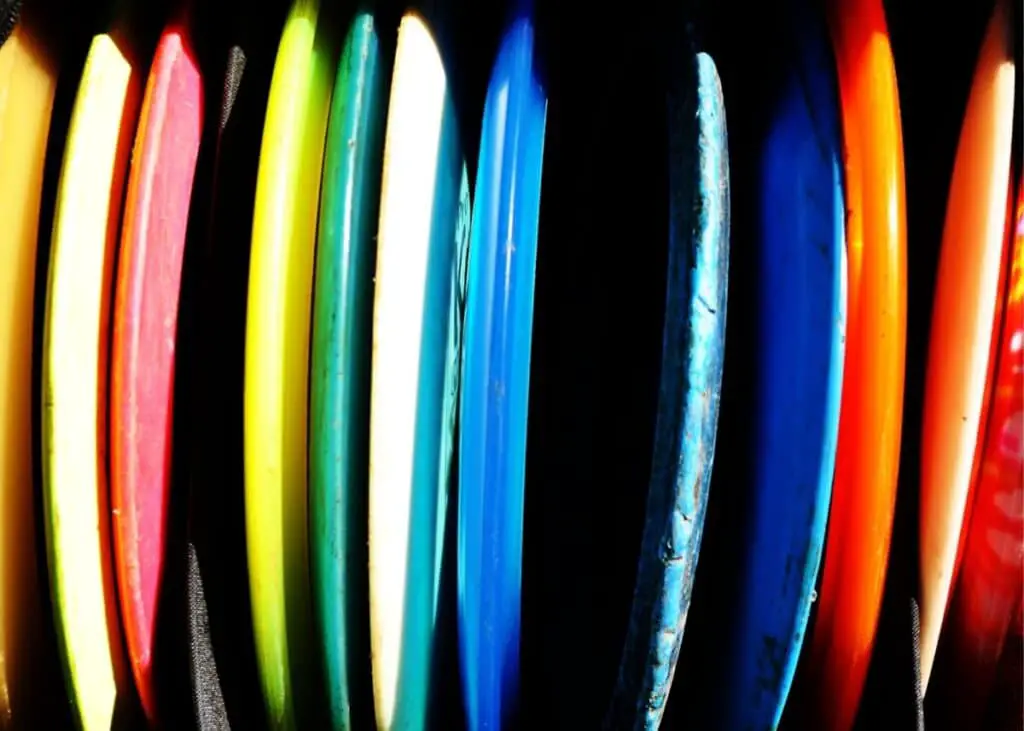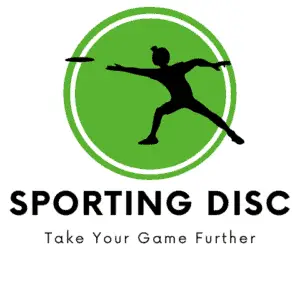Some disc golf players carry bags full of discs for every conceivable situation during a round of disc golf. But, if you’re a beginner only learning the ropes of disc golf there is only a bare minimum number of discs needed to cover most throws you’ll be making during a game.
In this article, I’m going to explain the basic number of discs a beginner needs to play a round of disc golf, and what the purpose is for each disc type you’ll need.
Table of Contents
Here’s How Many Discs a Beginner Should Have:
When playing disc golf, a beginner should have only three types of discs to start with. A beginner should use a driver, mid-range, and a putter. Carrying a duplicate of each type is good practice in case of a lost disc. Using these three different disc types, a beginner can make every throw required to complete almost any disc golf course.

How Many Different Discs Are There in Disc Golf?
Very advanced players will carry on average 20 discs or more in their bag any time they’re playing disc golf.
As you advance in your game, you’ll start to see how different situations might call for a slightly different disc that will fly or perform in a particular way.
Different combinations and variables can happen on any given hole that an experienced player will identify and use a particular disc to overcome.
For example, an awkward lie or a strong headwind might call for a specialized disc that will perform in a very specific way.
A very experienced player will be able to identify the type of throw needed and select the correct disc to make the shot. However, most of these players won’t use every disc in their bag when playing a course.
What Each Disc Golf Disc Type is Used For
If you’re just getting started playing disc golf, you know you’re going to primarily be using three discs: the driver, mid-range, and the putter. We’ll add one more optional disc for the beginner: the fairway driver.
Below are the beginner discs to use for disc golf and what their purpose is for each.
Distance Driver: Distance drivers are designed to provide the most range and glide when they’re thrown. Most distance drivers will provide a straight flight line when thrown and are made for long throws to start a hole.
Fairway Driver: Fairway drivers are very similar to distance drivers, but will give the player a little more control and accuracy when thrown. For beginners, a fairway driver isn’t going to make or break a hole, so don’t worry if you only have a distance driver.
Mid-Range: The mid-range disc is used after the drive, when you’re too far from the hole to use the putter, but too close to use the driver again. The mid-range offers even more tight control and accuracy when approaching a basket.
Putter: A putter is one of the most important discs in the bag for any player. The putter is a more rounded disc that increases control and decreases the speed so they won’t fly too far past the basket in case of a miss.
Flight Numbers For Disc Golf Discs
Each disc used in disc golf includes what are called flight numbers on the front of the disc. The flight number will give the player an idea of the characteristics of the disc when it’s thrown.
Here are the common disc flight numbers and what they mean:
Speed
Speed indicates the potential flight distance of the disc. The number will range from a low (1-3) to very high (10+).
For example, a putter will have a speed of 2-3, mid-range will have a speed of 4-6, a fairway driver will typically be between 7-9, while a distance driver will have a rating of 10+.
The speed of the disc doesn’t necessarily mean that the disc will fly the furthest, but when thrown properly, a disc with a higher speed flight number will have the greatest potential for distance because it will fly faster through the air.
Glide
Glide indicates the disc’s ability to stay airborne after being thrown. a Disc with a high glide rating will stay in the air longer than a disc with a lower glide rating.
These numbers will range from 1 to 7, with one being the least amount of glide, and 7 being the most. Higher glide ratings are most useful for longer shots when more distance is needed.
Lower glide ratings are good for short approaches when you don’t want to over-shoot a lay-up or the basket.
Fade
A disc will fade when used by a right-hand backhand thrower. The disc will tend to “fade” to the left after being thrown.
A disc with a higher fade will turn more sharply to the left and hit the ground at a steeper angle than a disc with a lower fade rating. The number on the disc for a fade will range from 0 to 5.
Turn
Fade and turn will determine the side-to-side characteristics of a disc in flight. Turn is the opposite of the fade rating.
A disc with a higher turn rating, when used by a right-hand backhand thrower, will angle to the right. The turn ratings are slightly different than the rest. A turn rating will range from +1 to a -5. Most turn ratings will appear on the disc as a negative number.
When throwing a disc backhand style with the right hand, you might always expect a disc to turn to the left, but a disc with a high turn rating (-5) will turn sharply to the right.
How Many Discs Should I Have In My Bag?
As a beginner, you should only be carrying around 6-8 discs in your bag. Again, these are the distance, mid-range, putter, and optional fairway driver. Also, carrying a spare of each is a good idea in case of a lost disc.
It’s important to learn to use these basic disc types first before buying a bag full of specialty discs.
As you advance in your game, you’ll understand how the discs are meant to fly and identify throwing lines that call for a specific disc. At this point, you’ll want to start adding discs to your bag to address these situations.
One more reason to add some discs to your bag is for spares. Losing a disc can happen, it’s happened to many people. Or, you might damage a disc, like from hitting a tree or other object.
In this case, it’s a good idea to have a spare ready to finish out the round.
How Many Discs Are Allowed in a Disc Golf Bag?
There are no restrictions on the number of discs a person can carry in their disc golf bag. The number of discs will mostly be limited by the holding capacity of the disc golf bag.
The experience level of the player can also determine the number of discs in the bag. But, most players will simply carry only as many discs as they are comfortable with using during play.
If you’re playing in a disc golf tournament, you can bring as many discs as you need. There are no rules to the number of discs allowed in a disc golf bag.
The only rule when it comes to the number of discs is to have at least one. Otherwise, you can’t play!
Can You Play Disc Golf with One Disc?
When it comes down to it, you can play an entire round of disc golf using only one disc. All you need is one. A person could even just use a normal frisbee to play if they wanted to.
There are no rules that say a person has to use special discs or have a huge selection of discs at their disposal. Using only one disc to play can either be by choice or necessity.
Some people might be playing for the first time, and only own one disc. There is nothing wrong with doing this either. Depending on the disc you’re using, you might be limited in the shots that can be made with the disc.
Some seasoned players choose to practice using one disc only. They do this if they are trying to learn a new disc. Using a single disc for practice can teach a player to learn to throw many different shots with the same disc.
How Many Discs Do Pros Carry?
Professional disc golf players will carry 20-25 discs in their bag at any given time. Some players might even carry as many as 40 discs in their bag.
Most players, even professionals will only routinely use 10-15 of these discs when playing on any course.
Here is a sample list of discs that a pro disc golf player might have in their bag:
- Roller Discs (1-3)
- Overstable Distance Driver
- Straight Distance Driver
- Understable Distance Driver
- Overstable Fairway Driver
- Straight Fairway Driver
- Understable Fairway Driver
- Overstable Utility/Mid-Range
- Overstable Mid-Range
- Straight Mid-Range
- Understable Mid-Range
- Approach Putter (Overstable)
- Approach Putter (Understable)
- Putter (1-3)
If you’re counting those, that’s about 20 discs, give or take depending on the player and their personal preferences. If you see a lot of discs on this list with funny names and descriptions, that’s OK too.
It’s not important to know what each disc does and means as a new player. This only goes to show that there are many different levels of skills.
These are specialized discs that are used by experienced players. For the beginner learning the basic throws, it’s not necessary to know what the discs are or how they are used until you gain some experience. These people are professionals for a reason.
Can You Rent Discs For Disc Golf?
Disc golf discs can be rented in certain locations. many discs are rented for a day at a time at a set price. A distance driver, putter, and mid-range disc can be rented on a per day or per hour basis at most courses that offer rentals.
Renting discs might sound like a silly idea, but if you’re wanting to just try some out before you buy, renting some discs to play might not be a bad idea.
On the other hand, buying a disc is not very expensive, and if it turns out you don’t like the disc or discover disc golf is not for you, there are options to resell the disc or be out $10 to $15. Either way, it’s not a large investment to try out a couple of discs and see for yourself.
If you’re visiting a different city, a great way to spend time with the family or alone is to try out the local disc golf course. Some larger courses will offer a disc rental. A rental can include a driver, mid-range, and a putter.
Summary | How Many Discs Are Needed For Disc Golf?
My final thoughts are this, three discs are all you need to get started playing and having fun. There is no need to intentionally overcomplicate things in the beginning.
The longer you play disc golf, the more discs you’re going to begin to accumulate for use in those tricky situations. But, those situations only come with lots of practice and experience.
If you have a new disc, you’re going to want to know when it should be used and how to use the disc in those tricky situations.
It’s a good idea to get the basics down first when you’re new to any sport, disc golf included. Learning how to use and throw the distance driver, mid-range, and the putter will go a long way to taking your disc golf game to the next level when you’re ready.
